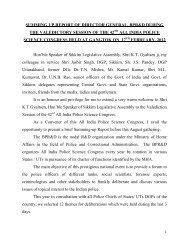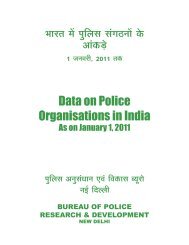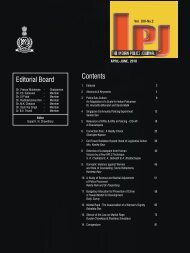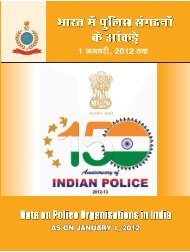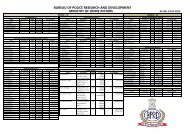Editorial Board Contents - Bureau of Police Research and ...
Editorial Board Contents - Bureau of Police Research and ...
Editorial Board Contents - Bureau of Police Research and ...
You also want an ePaper? Increase the reach of your titles
YUMPU automatically turns print PDFs into web optimized ePapers that Google loves.
“Sleeman sahib ki jai”“No Crime has been without a precedent”- SenecaShri Vijai Shukul, IPS (Retd.)No, this is not from ‘Jai ho’ <strong>of</strong> A.R. Rehman, buta charming <strong>and</strong> entirely spontaneous expression<strong>of</strong> joy <strong>and</strong> affection coming from the villagers <strong>of</strong>Saleemnabad, a town 70 kms from Jabalpur onhighway no. 7 towards Benaras. The occasionwas visit <strong>of</strong> the gr<strong>and</strong>son <strong>of</strong> Sir W.H. Sleeman,Col. James Lewis Sleeman, along with his son,on 6 th February 1937. Col. J.L. Sleeman wasaccompanied by G.W. Benton, IP (Suptd <strong>Police</strong>,Jabalpur). In the year 1836-37, Sir WilliamSleeman, while touring Jabalpur district, hadcome across a village named Khoka, where hesettled l<strong>and</strong>less labourers by taking 96 acres <strong>of</strong>l<strong>and</strong> from the Government as Maufi-l<strong>and</strong>. In1839, the village was named Saleemnabad afterthe name <strong>of</strong> its benefactor <strong>and</strong> a railway station<strong>of</strong> the same name st<strong>and</strong>s close by. About half amile from the village, there was a tiny hamlet,where, a holy man <strong>of</strong> Krishna order, namedBaba Haridas lived. Sleeman had already beenmarried for four years <strong>and</strong> had no children.While passing Khoka, Baba Haridas remarkedthat it was a holy place <strong>and</strong> all who came herewould be blessed with a son. Sleeman jokinglypromised, that if his prophecy came true, hewould present the village with a large sum <strong>of</strong>money. The prophecy did come true, as Sleemana year later, while camping at a village in Sagar,was blessed with a son. Sleeman, not forgettinghis promise, donated a large sum <strong>of</strong> money tothe village. Haridas by that time had died <strong>and</strong> ashrine was made in his memory. To perpetuatethe memory <strong>of</strong> the founder <strong>and</strong> the benefactor<strong>of</strong> the village, a brass lamp was placed in thememory <strong>of</strong> Sleeman, which continues to remainlit since last 150 years. Two ladies <strong>of</strong> the Sleemanfamily, out <strong>of</strong> curiosity, visited Khoka in recentyears <strong>and</strong> were also blessed with sons within ayear. The Sleeman family has, thus, continuedits association with Saleemnabad.During his visit Col. James Sleeman was takenout in a procession through triumphal arches <strong>and</strong>streets lined with buntings. Village ladies withshining bright brass ‘Lotas’, followed singing.The affection showered was for a man whomthey revered as ‘Baba Sleeman’. Under a hugeshamiana, the village elders presented Col. JamesSleeman with two memor<strong>and</strong>a. In the words <strong>of</strong>Col. James Sleeman, “for where else in the worldtoday would one find such generous expression<strong>of</strong> gratitude for services rendered over a centuryago”. Col. James L. Sleeman also visited theshrine <strong>of</strong> Baba Haridas to pay his obeisance, <strong>and</strong>the old police station building, designed by hisgr<strong>and</strong> father <strong>and</strong> constructed under his directionin 1843. The whole visit to Saleemnabad waslike a page from the Arabian Nights, so wroteCol. James Lewis Sleeman.On 8 th February 1937, Col. James Sleeman visitedthe Court House at Jabalpur, where Sleemansenior had tried more than 2000 Thugs. He wasintrigued by the stone pedestal upon which theThugs were made to sit during his gr<strong>and</strong>father'ssearching interrogations, with lights <strong>of</strong> threewindows directly upon them. He also met a 92yrs old Thug, a Kanjar, whom Sleeman had tried<strong>and</strong> was liberated at the age <strong>of</strong> 74. An acre <strong>of</strong>l<strong>and</strong> was given to settle the descendants <strong>of</strong> theThugs, which is today called the Kanjar mohalla,it is also called ‘Gur<strong>and</strong>i’ from the Persian word‘Goy<strong>and</strong>a’, which means, one who speaks, thatis an approver.Col. James Sleeman also visited the site <strong>of</strong> the oldjail, which no longer exists <strong>and</strong> the reformatoryschool called the Darikhana or the School <strong>of</strong>Industry, presently with the Home Guards,Jabalpur. There he met the descendants <strong>of</strong> theThugs. A plaque is still embedded on the wall<strong>of</strong> the building to commemorate the founding <strong>of</strong>The Indian <strong>Police</strong> Journal, October - December, 2012, Special Issue 1





